
A holotype is a single physical example of an organism, known to have been used when the species was formally described. It is either the single such physical example or one of several examples, but explicitly designated as the holotype. Under the International Code of Zoological Nomenclature (ICZN), a holotype is one of several kinds of name-bearing types. In the International Code of Nomenclature for algae, fungi, and plants (ICN) and ICZN, the definitions of types are similar in intent but not identical in terminology or underlying concept.

In zoological nomenclature, a type species is the species name with which the name of a genus or subgenus is considered to be permanently taxonomically associated, i.e., the species that contains the biological type specimen(s). A similar concept is used for suprageneric groups and called a type genus.

In biology, a type is a particular specimen of an organism to which the scientific name of that organism is formally attached. In other words, a type is an example that serves to anchor or centralizes the defining features of that particular taxon. In older usage, a type was a taxon rather than a specimen.

Eleotridae is a family of fish commonly known as sleeper gobies, with about 34 genera and 180 species. Most species are found in the tropical Indo-Pacific region, but there are also species in subtropical and temperate regions, warmer parts of the Americas and near the Atlantic coast in Africa. While many eleotrids pass through a planktonic stage in the sea and some spend their entire lives in the sea; as adults, the majority live in freshwater streams and brackish water. One of its genera, Caecieleotris, is troglobitic. They are especially important as predators in the freshwater stream ecosystems on oceanic islands such as New Zealand and Hawaii that otherwise lack the predatory fish families typical of nearby continents, such as catfish. Anatomically, they are similar to the gobies (Gobiidae), though unlike the majority of gobies, they do not have a pelvic sucker.

Claosaurus is a genus of hadrosauroid dinosaur that lived during the Late Cretaceous Period (Santonian-Campanian).
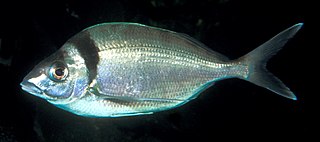
Nemadactylus macropterus, the tarakihi, jackass morwong or deep sea perch, is a species of marine ray-finned fish, traditionally regarded as belonging to the family Cheilodactylidae, the members of which are commonly known as morwongs. It is found in the south western Pacific Ocean, in Australia and New Zealand. Although there are records from the southern Indian Ocean and southwestern Atlantic, these may be due to misidentifications of similar species.
The Singapore whiskered bat is or was a possible species of vesper bat endemic to Singapore. No specimens have been found since its original scientific description in 1840 by Dutch zoologist Coenraad Temminck. Modern analysis of the type specimen found it to have skull fragments from another species and the skin to be in too poor a condition to confirm as distinct species.

The oblong turtle, also known commonly as the narrow-breasted snake-necked turtle and the southwestern snake-necked turtle, is a species of turtle in the family Chelidae. The species is endemic to the southwestern part of Western Australia.

The northern snake-necked turtle or northern long-necked turtle is a species of turtle in the family Chelidae or Austro-South American Side-necked Turtles. It is native to northern Australia and southern New Guinea.
Milyeringa is a genus of blind cavefish from the Cape Range and Barrow Island, northwestern Australia. Although traditionally considered to belong to the family Eleotridae, studies show that they represent a distinct and far-separated lineage together with the Typhleotris cavefish from Madagascar, leading some to move them to their own family, Milyeringidae. The generic name is taken from Milyering which is 20 miles (32 km) southwest of Vlamingh Head in the North West Cape of Western Australia, the type locality for Milyeringa veritas.
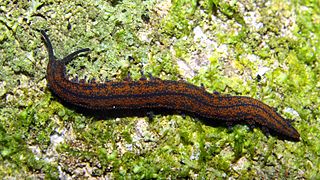
Peripatoides is a genus of velvet worms in the family Peripatopsidae, whose species are found in New Zealand. Like all velvet worms, these animals are nocturnal hunters that spit glue to trap their prey. Species of Peripatoides have 14, 15 or 16 pairs of legs. Female Peripatoides produce eggs that are fertilized internally and babies develop inside their mother until large enough to be born, in batches of 4-6, as colourless miniatures of the parents. These live-bearing Peripatoides have dermal-haemocoelic sperm transfer - which means sperm dissolve holes in the skin of the female to enter the body (haemolymph) anywhere on the body wall of the female.

The Gobiiformes are an order of fish that includes the gobies and their relatives. The order, which was previously considered a suborder of Perciformes, is made up of about 2,211 species that are divided between seven families. Phylogenetic relationships of the Gobiiformes have been elucidated using molecular data. Gobiiforms are primarily small species that live in marine water, but roughly 10% of these species inhabit fresh water. This order is composed chiefly of benthic or burrowing species; like many other benthic fishes, most gobiiforms do not have a gas bladder or any other means of controlling their buoyancy in water, so they must spend most of their time on or near the bottom. Gobiiformes means "Goby-like".

Cavefish or cave fish is a generic term for fresh and brackish water fish adapted to life in caves and other underground habitats. Related terms are subterranean fish, troglomorphic fish, troglobitic fish, stygobitic fish, phreatic fish and hypogean fish.
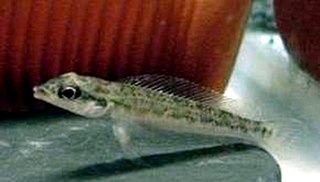
The Cichlinae are a subfamily of fishes in the cichlid family, native to South America.

Heroini is a fish tribe from the Cichlasomatinae subfamily in the cichlid family. All cichlids native to the Greater Antilles, United States, Mexico and northern Central America are members of this tribe. It also includes most cichlid species in southern Central America and several species from South America. A large percentage of its species were formerly placed in the genus Cichlasoma, but have since been moved to other genera.
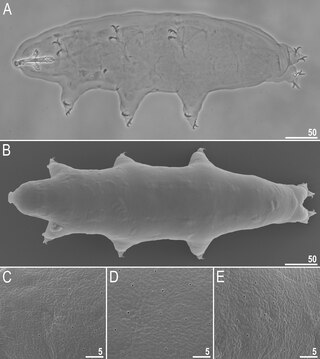
Macrobiotus shonaicus is a species of tardigrade in the family Macrobiotidae. As of 2018 it is only known from its type locality: Tsuruoka, Japan. The species description was published in 2018. The insides of their first three pairs of legs have a slight fold above their claws, and their eggs have processes whose terminal discs split off into thin filaments.
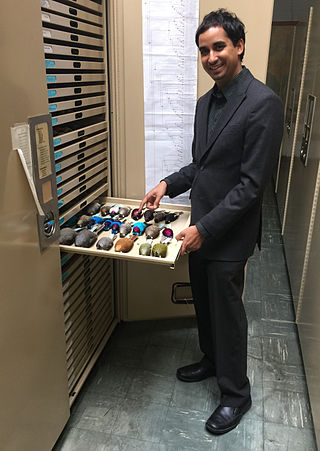
Prosanta Chakrabarty is an American ichthyologist and professor of ichthyology, evolution and systematics at Louisiana State University. He studied at McGill University where he received a bachelor of science in Applied Zoology and at the University of Michigan where he obtained his PhD in Ecology and Evolution. Among other professional positions he was a Program Director for the National Science Foundation and is currently the President-Elect of the American Society of Ichthyologist and Herpetologist. He was named a TED Fellow in 2016, and a TED Senior Fellow in 2018. He was named an Elected Fellow of the AAAS for "distinguished contributions to evolutionary biology, focusing on the bioluminescent systems and historical biogeography of freshwater fishes, and for effectively communicating science to the public."
Carole C. Baldwin is a research zoologist, curator of fishes, and the vertebrate zoology department chair at the National Museum of Natural History. She researches the diversity and evolution of coral reef and deep sea fishes through integrative taxonomy. She is on the board of directors of the National Aquarium in Washington, D.C. She is a senior author on the educational seafood cookbook One Fish, Two Fish, Crawfish, Bluefish - The Smithsonian Sustainable Seafood Cookbook, and the principal investigator on the Deep Reef Observation Project (DROP) which researches reefs to 300 meter depths. She was inducted into the Women Divers Hall of Fame in 2003.
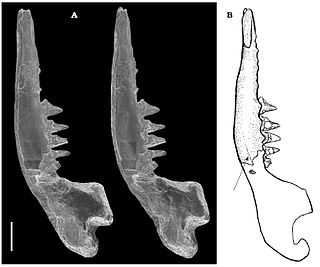
Symmetrolestes is an extinct genus of small spalacotheriid mammal from the Early Cretaceous period of Japan. The genus contains one species known as S. parvus, the type fossil is from fluvial deposits located in the Dinosaur Quarry in the Kitadani Formation, near the city of Katsuyama which lies alongside valley of the Sugiyamagawa River. It was described by Tsubamoto and Rougier in 2004 keeping the Holotype at the National Science Museum, Tokyo, Japan.
The Wells and Wellington affair was a dispute about the publication of three papers in the Australian Journal of Herpetology in 1983 and 1985. The periodical was established in 1981 as a peer-reviewed scientific journal focusing on the study of amphibians and reptiles (herpetology). Its first two issues were published under the editorship of Richard W. Wells, a first-year biology student at Australia's University of New England. Wells then ceased communicating with the journal's editorial board for two years before suddenly publishing three papers without peer review in the journal in 1983 and 1985. Coauthored by himself and high school teacher Cliff Ross Wellington, the papers reorganized the taxonomy of all of Australia's and New Zealand's amphibians and reptiles and proposed over 700 changes to the binomial nomenclature of the region's herpetofauna.















